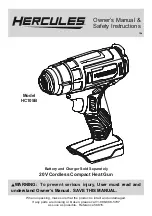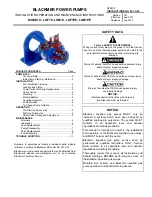
Page 3
For technical questions, please call 1-888-866-5797.
Item 56815
12. People with pacemakers should consult their
physician(s) before use. Electromagnetic fields in
close proximity to heart pacemaker could cause
pacemaker interference or pacemaker failure.
13. The warnings, precautions, and instructions
discussed in this instruction manual cannot
cover all possible conditions and situations
that may occur. It must be understood by the
operator that common sense and caution are
factors which cannot be built into this product,
but must be supplied by the operator.
Power Tool Use and Care
1. Do not force the power tool.
Use the correct
power tool for your application.
The correct
power tool will do the job better and safer
at the rate for which it was designed.
2. Do not use the power tool if the switch
does not turn it on and off. Any power tool
that cannot be controlled with the switch
is dangerous and must be repaired.
3. Disconnect the plug from the power source and/
or remove the battery pack, if detachable, from
the power tool before making any adjustments,
changing accessories, or storing power tools.
Such preventive safety measures reduce the
risk of starting the power tool accidentally.
4. Store idle power tools out of the reach of
children and do not allow persons unfamiliar
with the power tool or these instructions to
operate the power tool. Power tools are
dangerous in the hands of untrained users.
5. Maintain power tools and accessories.
Check
for misalignment or binding of moving
parts, breakage of parts and any other
condition that may affect the power tool’s
operation. If damaged, have the power tool
repaired before use.
Many accidents are
caused by poorly maintained power tools.
6. Keep cutting tools sharp and clean. Properly
maintained cutting tools with sharp cutting edges
are less likely to bind and are easier to control.
7. Use the power tool, accessories and tool bits
etc.
in accordance with these instructions,
taking into account the working conditions
and the work to be performed.
Use of the
power tool for operations different from those
intended could result in a hazardous situation.
8. Keep handles and grasping surfaces dry, clean
and free from oil and grease. Slippery handles and
grasping surfaces do not allow for safe handling
and control of the tool in unexpected situations.
Service
1. Have your power tool serviced by a
qualified repair person using only identical
replacement parts. This will ensure that the
safety of the power tool is maintained.
2. Maintain labels and nameplates on the tool.
These carry important safety information.
If unreadable or missing, contact
Harbor Freight Tools for a replacement.
Heat Gun Safety Warnings
1.
Hidden areas behind walls, ceilings, floors,
soffit boards, and other panels may contain
flammable materials that could be ignited by
the heat gun when working in these locations.
The ignition of these materials may not be
readily apparent and could result in property
damage and injury to persons. When working in
these locations, keep the heat gun moving in a
back-and-forth motion.
Lingering or pausing in one spot could ignite
the panel or the material behind it.
2.
Extreme care should be taken when stripping
paint.
The peelings, residue and vapors of paint
may contain lead, which is poisonous. Any pre-1977
paint may contain lead and paint applied to homes
prior to 1950 is likely to contain lead. Once
deposited on surfaces, hand-to-mouth contact can
result in the ingestion of lead. Exposure to even
low levels of lead can cause irreversible brain and
nervous system damage; young and unborn children
are particularly vulnerable. Before beginning
any paint removal process you should determine
whether the paint you are removing contains lead.
This can be done by your local health department
or by a professional who uses a paint analyzer to
check the lead content of the paint to be removed.
LEAD BASED PAINT SHOULD ONLY BE
REMOVED BY A PROFESSIONAL AND SHOULD
NOT BE REMOVED USING A HEAT GUN.
3.
Persons removing paint should
follow these guidelines:
a. Move the work piece outdoors.
If this is not possible, keep the work area well
ventilated. Open the windows and put an
exhaust fan in one of them. Be sure the fan
is moving the air from inside to outside.
b. Remove or cover any carpets, rugs, furniture,
clothing, cooking utensils and air ducts.
c. Place drop cloths in the work area to catch any
paint chips or peelings. Wear protective clothing
such as extra work shirts, overalls and hats.






























